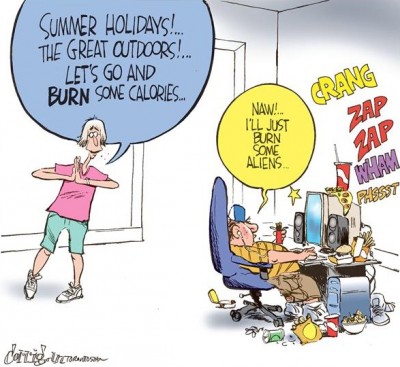Just as the Summer Olympics are poised to begin in London, we receive disturbing news about the health of American youth.
A new Centers For Disease Control report reveals that nearly half of surveyed U.S. high school students reported their week included NO PHYSICAL EDUCATION CLASSES. And according to the Journal of Teaching in Physical Education, of the 41 states that require P.E. at the elementary school level, only six (!) meet the recommended guidelines from the National Association of Sport and Physical Education.
 Whence cometh our next generation of Olympic athletes? From a generation that sees the Olympic rings and thinks “Mmm…doughnuts”? From a generation that, instead of competing to join the Olympic Torch relay whines, “Hey, bring me that Bic lighter from waaaaay down on the other end of the coffee table”?
Whence cometh our next generation of Olympic athletes? From a generation that sees the Olympic rings and thinks “Mmm…doughnuts”? From a generation that, instead of competing to join the Olympic Torch relay whines, “Hey, bring me that Bic lighter from waaaaay down on the other end of the coffee table”?
Recession-spawned budget cuts are the main culprit in the downsizing of physical education (as well as art and music classes). That sounds penny wise and pound foolish. Or at least hauntingly similar to Vietnam War strategy. (“In order to TRIM THE FAT from the budget, we had to settle for out-of-shape kids.”)
21st century schools (remember when that was a GOOD thing?) also devote inordinate amounts of time to prepping students for mandatory standardized testing (the old “teaching to the test” dilemma). I call the policy No Child Left Behind — Except The Little Couch Potatoes Who Can’t Get Out Of Their Seats And Who’d Better Hope The Building Doesn’t Catch Fire.
Furthermore, the states have notoriously ambiguous criteria for what constitutes “physical education.” P.E. might include the cardiovascular benefits of “jumping to conclusions,” the invigorating benefits of English 101 plagiarism (“the students were able to LIFT ENTIRE PARAGRAPHS”) and the cholesterol-conquering effects of synchronized slacking.
Make no mistake: the issue goes far beyond obesity or the Olympics. Even the proverbial 98-pound weakling can be unhealthy, unchallenged and unaware of his potential. And students with little in-school exercise (and a life of texting and video games at home) may be poor candidates for the labor force. (There aren’t many jobs — including parent — that don’t call for a certain amount of stamina, rules adherence and teamwork.)
The P.E. crisis has a whole “Revenge of the Nerds” vibe to it (I’ll admit to my own aching sides from running laps and neck spasms from staring hopelessly at the gym rope), but let’s not be shortsighted. Even geeks need P.E. According to Dr. John J. Ratey’s book “Spark: The Revolutionary New Science of Exercise And The Brain,” a regular exercise regimen makes students perform better academically and on the aforementioned standardized tests.
All students need to learn about diet, nutrition and fair play. All students need exposure to a variety of sports and exercises so they can make an educated decision about future pursuits. Every student needs a sound mind in a sound body.
A few concerned citizens are looking into the matter, but we need a vigorous grassroots movement to persuade local and state officials to restore and amplify P.E. classes. We need more than handwringing.
(“Hey, as an administrator, I’ve been doing an awful LOT of handwringing. I wonder if I could go back and get retroactive P.E. credit for that on my old high school Grade Point Average…?”)
- Father’s Day: Can It Survive? - June 16, 2013
- Beware the Infrastructure, My Son - June 4, 2013
- Revolution: Armed Rebellion in America by 2018? - May 16, 2013

